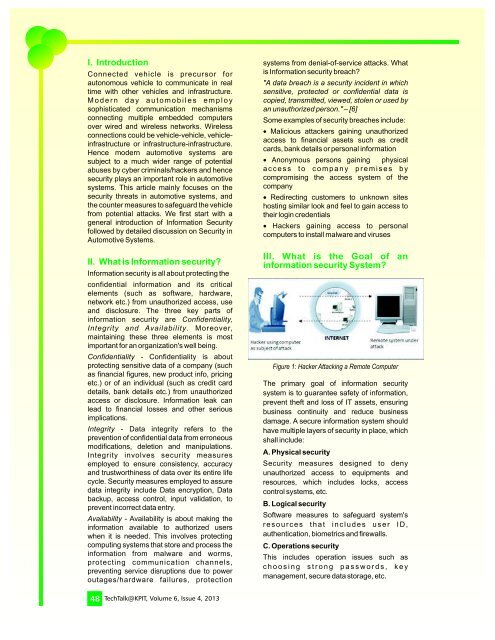Autonomous Vehicles - KPIT
Autonomous Vehicles - KPIT
Autonomous Vehicles - KPIT
You also want an ePaper? Increase the reach of your titles
YUMPU automatically turns print PDFs into web optimized ePapers that Google loves.
I. Introduction<br />
Connected vehicle is precursor for<br />
autonomous vehicle to communicate in real<br />
time with other vehicles and infrastructure.<br />
M o d e r n d a y a u t o m o b i l e s e m p l o y<br />
sophisticated communication mechanisms<br />
connecting multiple embedded computers<br />
over wired and wireless networks. Wireless<br />
connections could be vehicle-vehicle, vehicleinfrastructure<br />
or infrastructure-infrastructure.<br />
Hence modern automotive systems are<br />
subject to a much wider range of potential<br />
abuses by cyber criminals/hackers and hence<br />
security plays an important role in automotive<br />
systems. This article mainly focuses on the<br />
security threats in automotive systems, and<br />
the counter measures to safeguard the vehicle<br />
from potential attacks. We first start with a<br />
general introduction of Information Security<br />
followed by detailed discussion on Security in<br />
Automotive Systems.<br />
II. What is Information security?<br />
Information security is all about protecting the<br />
confidential information and its critical<br />
elements (such as software, hardware,<br />
network etc.) from unauthorized access, use<br />
and disclosure. The three key parts of<br />
information security are Confidentiality,<br />
Integrity and Availability. Moreover,<br />
maintaining these three elements is most<br />
important for an organization's well being.<br />
Confidentiality - Confidentiality is about<br />
protecting sensitive data of a company (such<br />
as financial figures, new product info, pricing<br />
etc.) or of an individual (such as credit card<br />
details, bank details etc.) from unauthorized<br />
access or disclosure. Information leak can<br />
lead to financial losses and other serious<br />
implications.<br />
Integrity - Data integrity refers to the<br />
prevention of confidential data from erroneous<br />
modifications, deletion and manipulations.<br />
Integrity involves security measures<br />
employed to ensure consistency, accuracy<br />
and trustworthiness of data over its entire life<br />
cycle. Security measures employed to assure<br />
data integrity include Data encryption, Data<br />
backup, access control, input validation, to<br />
prevent incorrect data entry.<br />
Availability - Availability is about making the<br />
information available to authorized users<br />
when it is needed. This involves protecting<br />
computing systems that store and process the<br />
information from malware and worms,<br />
protecting communication channels,<br />
preventing service disruptions due to power<br />
outages/hardware failures, protection<br />
systems from denial-of-service attacks. What<br />
is Information security breach?<br />
"A data breach is a security incident in which<br />
sensitive, protected or confidential data is<br />
copied, transmitted, viewed, stolen or used by<br />
an unauthorized person." – [6]<br />
Some examples of security breaches include:<br />
•Malicious attackers gaining unauthorized<br />
access to financial assets such as credit<br />
cards, bank details or personal information<br />
•Anonymous persons gaining physical<br />
a c c e s s t o c o m p a n y p r e m i s e s b y<br />
compromising the access system of the<br />
company<br />
•Redirecting customers to unknown sites<br />
hosting similar look and feel to gain access to<br />
their login credentials<br />
•Hackers gaining access to personal<br />
computers to install malware and viruses<br />
III. What is the Goal of an<br />
information security System?<br />
Figure 1: Hacker Attacking a Remote Computer<br />
The primary goal of information security<br />
system is to guarantee safety of information,<br />
prevent theft and loss of IT assets, ensuring<br />
business continuity and reduce business<br />
damage. A secure information system should<br />
have multiple layers of security in place, which<br />
shall include:<br />
A. Physical security<br />
Security measures designed to deny<br />
unauthorized access to equipments and<br />
resources, which includes locks, access<br />
control systems, etc.<br />
B. Logical security<br />
Software measures to safeguard system's<br />
r e s o u r c e s t h a t i n c l u d e s u s e r I D ,<br />
authentication, biometrics and firewalls.<br />
C. Operations security<br />
This includes operation issues such as<br />
c h o o s i n g s t r o n g p a s s w o r d s , k e y<br />
management, secure data storage, etc.<br />
48 TechTalk@<strong>KPIT</strong>, Volume 6, Issue 4, 2013


